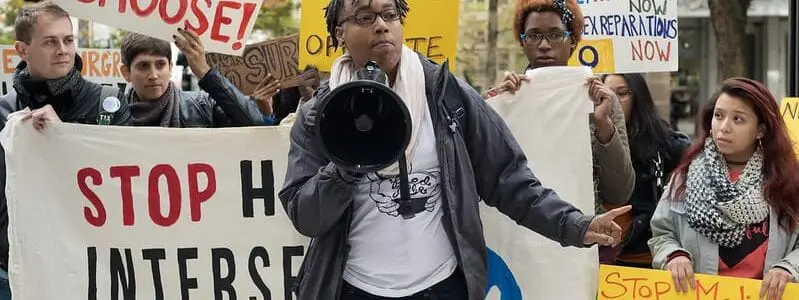Bioethics Forum Essay
A Historic Intersex Awareness Day
This year’s Intersex Awareness Day, October 26, marks a historic pivot. Last week, Boston Children’s Hospital revealed that its physicians would no longer perform certain nonconsensual infant genital surgeries on babies born with atypical genitals. They join the Ann and Robert H. Lurie Children’s Hospital in Chicago, which made a similar announcement in July and even apologized to its former intersex patients: “We empathize with intersex individuals who were harmed by the treatment that they received according to the historic standard of care and we apologize and are truly sorry.”
Intersex advocates have been working toward this goal for decades, trying to convince physicians (and parents) that surgically changing the appearance of babies’ genitals simply to look “normal” is a bad idea. It might seem counterintuitive for physicians not to “fix” anatomical differences—particularly ones long regarded (wrongly) as abnormalities. But as intersex advocates have argued—now with material success—such surgical interventions are often medically unnecessary and done for cosmetic reasons.
Since the 1950s, operations to remodel the genitals of intersex babies have been standard. Earlier, surgeons had focused their attention on intersex adults, able to refuse doctors’ suggestions to surgically “repair” their genitals and sometimes to change their gender presentation as well. Some patients in the process endured horrific surgeries and experienced ongoing injury. Others refused and lived with their bodily difference. In the 1950s, Dr. John Money, a psychologist at Johns Hopkins, and his colleagues hypothesized that if surgeries were performed on infants, who had not yet formed their gender identity (so the thinking went), parents would find it easier to raise them in their surgically-assigned gender. Money’s team wrote scores of authoritative articles on the subject, and well-intentioned doctors around the world followed their lead.
But by the 1990s patients who had undergone such surgeries in the 1950s and 1960s had grown up, and they increasingly testified to the failure and debilitating consequences of those operations. Some felt uncomfortable in the genders their doctors had surgically imposed. Many suffered physically, with pain, scarring, incontinence, and lack of sexual sensation, and felt the shame of countless furtive medical check-ups (physicians recommended parents keep this secret), which could include invasive documentary medical photography that many considered demeaning.
Intersex activists, such as interACT and Intersex Justice Project, have contested such practices and recently have made enormous progress. In response, the World Health Organization, the United Nations, Human Rights Watch, National Institutes of Health, and Amnesty International, have drawn attention to the human rights abuses facing intersex youth and called for the cessation of nonconsensual intersex genital surgeries. Government agencies in Germany, Switzerland, Australia, Chile, Argentina, and the U.S. have also agreed that early childhood surgeries should not be performed merely for social reasons and without the patient’s consent.
Despite a growing critique of the historic standard of care, many leading physicians have persisted, insisting that children born with intersex will be better off if their anatomy looks “normal” and arguing that this is what parents want. But parents are not the patients. Though typically parents do make medical decisions for their children, intersex care requires a different approach, one that takes into consideration factors that are yet unknown: the child’s future gender and sexual identity. Thankfully, an increasing number of physicians are starting to reconsider their positions. Lurie’s candid apology said it all: “the medical field has failed these children.”
Some intersex conditions remain outside the recent hospital bans. Lurie, for instance, is still considering what to do about CAH, congenital adrenal hyperplasia (a group of genetic conditions that affects the adrenal glands and can cause atypical genitals), though at Boston Children’s Hospital, it will remain under the intersex umbrella, as it should. CAH patients represent the largest number of infant genital surgeries, but they also have the strongest parent advocacy group who do not consider CAH children “intersex” at all. According to these parents, girls with CAH (boys are affected differently) merely have “external genital anomalies,” and most will identify as women when they mature. Yet this is a distinction without a difference; the surgeries are the same, and no matter their future gender identity, those born with atypical genitals should have the right to make their own decisions about their body and its function, once they are old enough to participate.
Shared decision-making between parents of affected children and their physicians, if it lacks input from patients themselves, is not actually shared. Parents and physicians cannot predict children’s future sexual desires and gender identities as they grow older, and we should exercise caution and restraint regarding medical decisions, especially surgical interventions, based on speculation.
On today’s Intersex Awareness Day, let’s hope that more hospitals follow in the ethical footsteps of Lurie and BCH, even broadening the scope of their prohibitions to include all nonconsensual genital normalizing surgeries and holding themselves accountable for their past actions.
Elizabeth Reis is a professor of gender and bioethics at the Macaulay Honors College at the City University of New York and the author of Bodies in Doubt: An American History of Intersex. A second edition of the book will be released in July 2021. Twitter: @lzreis
[Photo: Sarah-Ji, Love & Struggle Photos]













